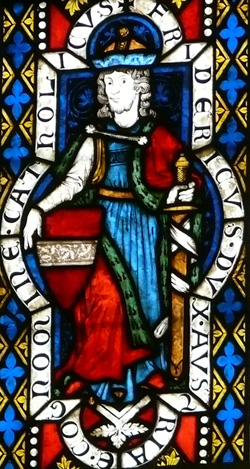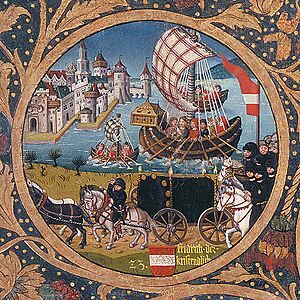Frederick I, Duke of Austria (Babenberg) facts for kids
Quick facts for kids
Frederick I
|
|
|---|---|
| Duke of Austria | |

Frederick I on a 13th century stained glass window in Heiligenkreuz Abbey
|
|
| Duke | 1195–1198 |
| Predecessor | Leopold V |
| Successor | Leopold VI |
| Born | c. 1175 |
| Died | 26 April 1198 (aged 22–23) Acre, Kingdom of Jerusalem |
| Buried | Heiligenkreuz Abbey |
| Family | House of Babenberg |
| Father | Leopold V |
| Mother | Helena of Hungary |
Frederick I (German: Friedrich I. von Österreich), born around 1175, was also known as Frederick the Catholic (German: Friedrich der Katholische). He was a powerful ruler, or Duke, of Austria from 1195 to 1198. Frederick belonged to the important House of Babenberg family.
Contents
Becoming Duke of Austria
Frederick the Catholic was born in 1175. His parents were Duke Leopold V of Austria and Helena of Hungary. In 1192, Frederick and his father were given control of Austria and Styria. His younger brother, Leopold VI, did not receive any land at this time.
Dividing the Duchy
When Leopold V was dying, he made a surprising decision. He gave the Duchy of Styria to his younger son, Leopold VI. This decision was approved by Emperor Henry VI. No one objected, so Austria and Styria became separate lands. Frederick the Catholic became the Duke of Austria. He received his land through Wolfger of Erla, the Bishop of Passau, who acted on behalf of the Emperor.
Dealing with England
When Frederick became Duke in 1195, he faced a big problem. He had to return English hostages and money that had been paid for King Richard I of England's release. King Richard was pushing hard for their return. Frederick sent the hostages back right away. He also returned the money that had not been spent.
Frederick had been planned to marry King Richard's niece, Eleanor. But because of the issues with the ransom money, this marriage was cancelled. Eleanor was also sent back to England.
Joining a Crusade
To make up for his father's actions and restore his family's honor, Frederick decided to join another Crusade. A Crusade was a religious war supported by the Catholic Church. On Easter, March 31, 1195, he officially joined the Crusade in Bari, Italy. The leader of the Muslim forces, Saladin, had died in 1193. This made the chances for the Crusade seem good.
However, in March 1196, Pope Celestine III got involved. He approved of the actions of Adalbert, a church leader, and strongly criticized Frederick's late father, Leopold V.
The German Crusade of 1197
There were many delays before the Crusade could begin. The German Emperor, Henry VI, had been trying to make the Empire hereditary. This meant he wanted his family to always rule. He spent a lot of time trying to convince princes and church leaders to vote for his plan. But he was not successful. In the end, the Emperor stopped his hereditary plans to focus on the Crusade.
Journey to the Holy Land
Duke Frederick left Austria in the spring of 1197. He traveled with Wolfger, Bishop of Passau, and his uncle, Henry I, Duke of Mödling. They stopped in Linaria to rest. On their way to Sicily, two ships sank, but they continued their journey. By June, they were welcomed at Emperor Henry's court in Sicily. The Emperor took charge and arranged for the Crusader fleet to sail.
In September, they sailed from Messina under the leadership of Conrad, Archbishop of Mainz. Weeks later, they arrived in Acre, a city in the Holy Land.
Battles and Victories
In Acre, the German forces were led by Conrad of Mainz. However, the German princes, including Frederick, did not want Marshal Henry of Kalden to lead. They chose Duke Henry I of Brabant to lead the attack against the Ayyubids, who were led by Al-Adil.
Their forces gathered and marched to Tyre, taking the city easily. Then they captured the wealthy city of Sidon. On October 24, they entered Beirut. Suddenly, news arrived that King Henry I of Jerusalem had died. He had fallen from his palace balcony in Acre. The German forces immediately returned to Acre. Duke Henry of Brabant acted as a temporary ruler.
A New King for Jerusalem
Preparations were quickly made for Almaric of Cyprus to become King of Jerusalem. The German princes urged Amalric to marry Isabella, the queen of Jerusalem. Amalric married Isabella and was crowned King of Jerusalem in Acre in 1198.
The Germans marched again. They recaptured lands around Byblos Castle (Gibelet). This helped connect their land to the County of Tripoli. They marched towards Damascus and even began to attack Toron.
Frederick's Final Days
Suddenly, news arrived that Emperor Henry VI had died. Many German princes immediately left for their homelands. They needed to confirm their lands with the new Emperor. Duke Frederick, however, stayed with Wolfger to continue the war. In the end, Frederick and the remaining Germans made a peace agreement with Al-Adil. Al-Adil recognized King Amalric's rule over the lands they had recaptured.
Frederick became ill and died on April 16, 1198, in Acre. He was returning from Palestine. His companions, including Meinhard II, Count of Gorizia, Wolfger, Bishop of Passau, and others, were with him. Frederick never married. He was much loved by his people. The famous poet Walther von der Vogelweide especially mourned his death.
Wolfger performed a German funeral custom called Mos Teutonicus on Frederick's body. This was done before bringing him back home. Frederick was then buried next to his father in Heiligenkreuz Abbey. They rest there peacefully to this day.
See also
- List of rulers of Austria


